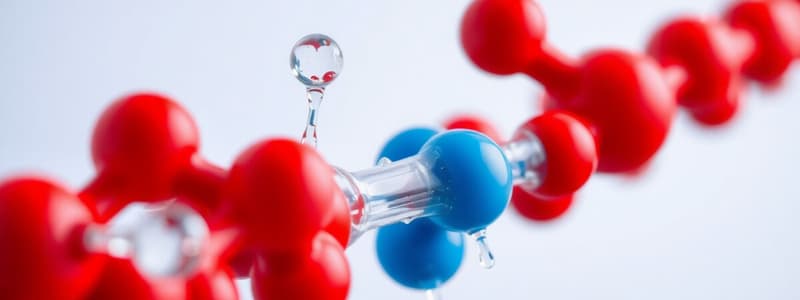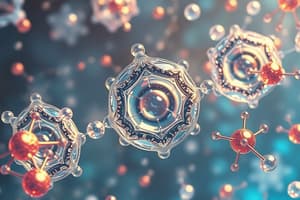Podcast
Questions and Answers
What property of water allows it to absorb a large amount of energy before increasing in temperature?
What property of water allows it to absorb a large amount of energy before increasing in temperature?
- Moderation of temperature (correct)
- Expansion upon freezing
- Solvent property
- Cohesion
Ice sinks in water because it is denser than liquid water.
Ice sinks in water because it is denser than liquid water.
False (B)
What are substances that do not dissolve easily in water called?
What are substances that do not dissolve easily in water called?
hydrophobic
The pH of blood must be maintained between __________.
The pH of blood must be maintained between __________.
Match the following biological molecules with their respective classes:
Match the following biological molecules with their respective classes:
Which of the following describes the relationship between organic molecules and their functional groups?
Which of the following describes the relationship between organic molecules and their functional groups?
Hydrogen bonds in water molecules are weak and insignificant.
Hydrogen bonds in water molecules are weak and insignificant.
What do we call the basic building blocks that make up polymers in biological molecules?
What do we call the basic building blocks that make up polymers in biological molecules?
What are nonprotein molecules that assist enzyme catalysis called?
What are nonprotein molecules that assist enzyme catalysis called?
Enzymes are consumed in the reactions they catalyze.
Enzymes are consumed in the reactions they catalyze.
What is the role of ATP in the cell?
What is the role of ATP in the cell?
The inactive forms of enzymes are called __________.
The inactive forms of enzymes are called __________.
Match each type of RNA with its function:
Match each type of RNA with its function:
Which of the following correctly describes the 'lock and key' mechanism of enzymes?
Which of the following correctly describes the 'lock and key' mechanism of enzymes?
DNA is single-stranded.
DNA is single-stranded.
Name the four classes of biological molecules.
Name the four classes of biological molecules.
A change in the nucleotide sequence of DNA is called a __________.
A change in the nucleotide sequence of DNA is called a __________.
Which of the following bases is found in RNA but not in DNA?
Which of the following bases is found in RNA but not in DNA?
What is the primary monomer of carbohydrates?
What is the primary monomer of carbohydrates?
Polysaccharides are made up of multiple monosaccharides joined together.
Polysaccharides are made up of multiple monosaccharides joined together.
What type of linkage occurs when monosaccharides are joined together?
What type of linkage occurs when monosaccharides are joined together?
Glycogen is a storage polysaccharide of __________.
Glycogen is a storage polysaccharide of __________.
Which of the following is a characteristic of saturated fatty acids?
Which of the following is a characteristic of saturated fatty acids?
Phospholipids are hydrophobic molecules.
Phospholipids are hydrophobic molecules.
What is the role of cholesterol in biological membranes?
What is the role of cholesterol in biological membranes?
The building blocks of proteins are called __________.
The building blocks of proteins are called __________.
What type of bond connects amino acids in a protein?
What type of bond connects amino acids in a protein?
Fibrous proteins are typically water-soluble.
Fibrous proteins are typically water-soluble.
Define denaturation in proteins.
Define denaturation in proteins.
Match the type of lipid with its description:
Match the type of lipid with its description:
The primary structure of a protein is determined by its __________.
The primary structure of a protein is determined by its __________.
Which of the following is NOT a type of lipid?
Which of the following is NOT a type of lipid?
Humans can digest cellulose due to the enzymes present in their digestive system.
Humans can digest cellulose due to the enzymes present in their digestive system.
Flashcards are hidden until you start studying
Study Notes
Water Properties
- Water exhibits cohesion due to hydrogen bonds between water molecules.
- Water is a good temperature moderator as it can absorb a significant amount of heat before its temperature changes.
- Water expands when it freezes, making ice less dense than liquid water and allowing aquatic life to survive in winter.
- Water is an excellent solvent due to its polarity, dissolving polar and charged substances.
- Hydrophilic substances readily dissolve in water, while hydrophobic substances like oils and lipids do not.
- Buffers help maintain stable pH levels, preventing drastic changes.
- Blood, composed of over 90% water, maintains a pH between 7.35 and 7.45.
- Hydrogen bonds are crucial for water’s properties and life processes.
Organic Molecules
- Organic molecules contain carbon as their fundamental building block.
- The simplest organic molecules are hydrocarbons, composed only of carbon and hydrogen.
- Functional groups attached to carbon skeletons determine the molecule’s chemical properties and functions.
- Biological molecules are complex organic compounds, primarily polymers formed from monomers.
Carbohydrates
- Carbohydrates contain carbon, hydrogen, and oxygen.
- They constitute 2-3% of the body's mass.
- Monosaccharides are the simplest carbohydrate monomers, like glucose, fructose, and galactose.
- Dehydration synthesis links monosaccharides, forming glycosidic bonds to create disaccharides and polysaccharides.
- Polysaccharides like glycogen (animal storage) and starch (plant storage) are polymers of glucose.
Lipids
- Lipids are hydrophobic molecules made of carbon, hydrogen, and a small proportion of oxygen.
- They represent 18-25% of human body mass.
- Fatty acids are the building blocks of many lipids, consisting of a hydrocarbon chain with a carboxyl group at one end.
- Saturated fatty acids have only single covalent C-C bonds, while unsaturated fatty acids contain one or more double bonds.
- Triglycerides, composed of glycerol and three fatty acids, are fats (solid at room temperature) or oils (liquid at room temperature).
- Phospholipids have a hydrophilic phosphate head and hydrophobic fatty acid tails, making them amphipathic molecules that form cell membranes.
- Steroids are lipids with four fused carbon rings, derived from cholesterol, which is important for membrane fluidity.
- Eicosanoids, including prostaglandins and leukotrienes, are signaling molecules involved in the immune system.
- Fat-soluble vitamins, like D, E, and K, are essential components of the diet.
Proteins
- Proteins are large molecules composed of carbon, hydrogen, oxygen, and nitrogen.
- They represent 12-18% of human body mass.
- Proteins are essential in determining the structure of body tissues.
- Amino acids, the monomers of proteins, have a central carbon atom bonded to an amino group, a carboxyl group, and a unique R group that determines the amino acid’s properties.
- Dehydration synthesis creates peptide bonds between amino acids, forming peptides and eventually polypeptides.
- Proteins have four levels of structure: primary (amino acid sequence), secondary (repeated folds), tertiary (three-dimensional shape), and quaternary (arrangement of polypeptide chains).
- Fibrous proteins are long and water-insoluble, like keratin and actin.
- Globular proteins are round and water-soluble, like antibodies and enzymes.
- Denatured proteins lose their structure and function.
Enzymes
- Enzymes are biological catalysts that accelerate chemical reactions without being consumed.
- Cofactors, including organic coenzymes, assist enzymes in catalysis.
- Enzymes bind substrates at their active site, facilitating chemical reactions.
- Enzymes are highly specific for their substrates based on a "lock and key" mechanism.
- Enzymes are efficient catalysts, lowering activation energy and increasing reaction rates.
- Cells regulate enzyme synthesis and activity, with proenzymes being inactive forms that become active under specific conditions.
Nucleic Acids
- Nucleic acids are made of carbon, hydrogen, oxygen, nitrogen, and phosphorus.
- They include DNA (deoxyribonucleic acid) and RNA (ribonucleic acid).
- DNA contains genes that encode for specific proteins.
- DNA is transcribed into RNA, which is translated into proteins by ribosomes.
- Nucleotides are the monomers of nucleic acids, consisting of a nitrogenous base, a pentose sugar, and a phosphate group.
- DNA contains the bases adenine (A), guanine (G), cytosine (C), and thymine (T).
- RNA contains adenine (A), guanine (G), cytosine (C), and uracil (U).
- Purines (A and G) are double-ring bases, while pyrimidines (T and C) are single-ring bases.
- In DNA, the pentose sugar is deoxyribose; in RNA, it's ribose.
- The backbone of nucleic acids is formed by alternating phosphate groups and pentose sugars.
- DNA forms a double helix due to the pairing of bases: A with T and G with C.
- DNA replication creates a new copy of the DNA double helix using one strand as a template.
- Mutations are changes in the DNA sequence.
- RNA is single-stranded and exists in three main types: messenger RNA (mRNA), ribosomal RNA (rRNA), and transfer RNA (tRNA).
ATP
- Adenosine triphosphate (ATP) is the energy currency of the cell.
- ATP is produced by exergonic reactions and consumed by endergonic reactions to perform cellular work.
- Hydrolysis of the terminal phosphate group in ATP releases energy.
- ATP synthesis is catalyzed by ATP synthase during aerobic cellular respiration.
Summary
- Biological molecules are diverse and essential for life.
- The four main classes of biological molecules are carbohydrates, lipids, proteins, and nucleic acids.
- Lipids are the only class that does not form polymers from monomers.
- The structure of biological molecules is directly linked to their function.
Studying That Suits You
Use AI to generate personalized quizzes and flashcards to suit your learning preferences.




